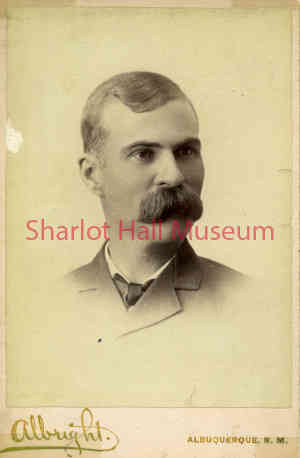Stephen Weaver (S.W.) Higley
details
Mrs. Albright Unknown po0914p.jpg PO-0914 Sepia 1700-0914-0001 po0914p Print 4x6 Photo Collections 1889 - 1890 Reproduction requires permission. Digital images property of SHM Library & ArchivesDescription
Stephen Weaver Higley (b. 1857 – d. 1935). A native of Ohio, he ran away from his father’s ranch while living in Missouri and was hired by a stagecoach company as a shotgun guard on stages that ran out west. When he was around 15 or 16, the Santa Fe Rail hired him to work in Kansas City as a laborer. Eventually, as a Santa Fe Rail superintendent, his work took him to Prescott, Arizona where the rail company was headquartered. While there, he is credited with building the short line between Arizona and California which ran through Parker, the Phoenix/Hayden, Arizona line and the Crown King Road.
After working on the line for 35 years, he resigned in 1909 and turned his endeavors to procuring land in the Salt River Valley for ranching, mainly sheep. He had extensive land holdings in Arizona near or in Higley, Avondale, and Tempe. His personal residences were listed in downtown Phoenix and Paradise Valley, where he had a 160+ acre ranch. He and his family purchased and lived in the Rosson house at Sixth and Monroe Streets in Phoenix.
In 1909, he and friend Sims Ely (b. 1862 - d. 1954) purchased the Arizona Republican newspaper (the Arizona Republic’s predecessor). He served as president while Ely was the general manager. In 1911, S.W. purchased Ely’s interest in the paper and then sold the publication to Dwight B. Heard (b. 1869 - d. 1929) in 1912. After the sale of the newspaper, he continued to pursue his ranching interests and moved to Oklahoma in 1925. He continued to ranch sheep until he died on July 26, 1935 in Woodward, Oklahoma.
He had three wives. With his first wife, Sarah Henson (b. 1867 - d. 1890), he had two children, Claude (who died in 1893 at age seven) and Thomas Henson (b. 1888 - d. 1961). He married his second wife, Jessie Howe (b. 1862 - d. 1938), in November 1890. With Jessie he had two children, Jessie Jean (JJ) (b. 1895 - d. 1993) and James (b. 1896 - d. 1918). Jessie was born in Illinois, the daughter of Civil War Union general John H. Howe (b. 1822 - d. 1873). She is buried in Prescott’s Mountain View Cemetery. After divorcing Jessie on an unknown date, S.W. married Olga G. Johnston (b. 1880 - d. unknown) in Los Angeles in 1920, and had another daughter, Cynthia (b. 1921 - d. 2008).
Sources: http://makehigleyhistoric.blogspot.com; Images of America, Historic Heritage Square, Arcadia Publishing, 1913.
Purchase
To purchase this image please click on the NOTIFY US button and we will contact you with details
The process for online purchase of usage rights to this digital image is under development. To order this image, CLICK HERE to send an email request for details. Refer to the ‘Usage Terms & Conditions’ page for specific information. A signed “Permission for Use” contract must be completed and returned. Written permission from Sharlot Hall Museum is required to publish, display, or reproduce in any form whatsoever, including all types of electronic media including, but not limited to online sources, websites, Facebook Twitter, or eBooks. Digital files of images, text, sound or audio/visual recordings, or moving images remain the property of Sharlot Hall Museum, and may not be copied, modified, redistributed, resold nor deposited with another institution. Sharlot Hall Museum reserves the right to refuse reproduction of any of its materials, and to impose such conditions as it may deem appropriate. For certain scenarios, the price for personal usage of the digital content is minimal; CLICK HERE to download the specific form for personal usage. For additional information, contact the Museum Library & Archives at 928-445-3122 ext. 14 or email: orderdesk@sharlot.org.




